#Tales of the Genji
Explore tagged Tumblr posts
Text

D O L L E D U P
The Tales Of Genji (1987)
2K notes
·
View notes
Text










Yoshitaka Amano: The Tale of Genji (2006)
1K notes
·
View notes
Text
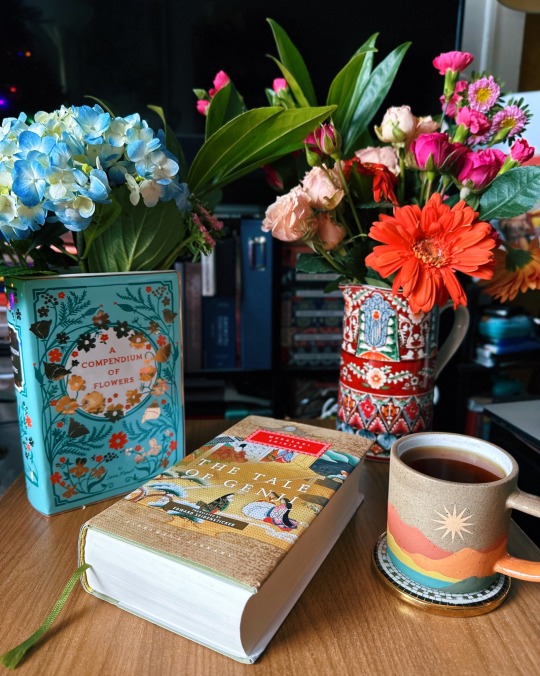
Genji is not a perfect person, but there’s a purity to him, a beauty that’s clearly meant to be lauded, particularly in contrast to later chapters. He’s in love with love, a true romantic, and his sometimes unwise affairs are motivated by a true sense of love. He never abandons one of his lovers, which in this time is crucial. No matter the shame it brings to himself, he tries to find a way to honor the women he’s fallen for. He’s charming. No one can not love him, or ultimately forgive him his faults.
The age of Tale of Genji had strict rules of romance—of how flirtations worked (largely intermediaries and poetry), of how commitments worked, of how aloof vs. present it was appropriate to be (it’s good to commit but bad to hoard or become jealous). It was possible to love too much. Genji is accused of this, but he always remembers to care for the people he is responsible for—once he grows up that is.
Early in the text, he neglects his wife, and he also neglects “the Rokujo lady.” The Rokujo lady becomes so jealous and enraged that her spirit begins to sicken his wife. This ghost returns more than once over the course of the text. She has grown sick from obsession and neglect, and Genji pays the price for it. It’s part of what motivates him to always care for the women he romances for the rest of his life.
Later, in the “Uji” chapters, young Kaoru and prince Niou also love too much. Niou is impulsive like Genji but also flighty, and Kaoru is serious like Genji but also obsessive. Both men pursue the women at Uji with insistence that the text can’t quite forgive as it could for Genji. Both, somehow, go too far—perhaps in their attempts to hoard, or in their impatience.
2K notes
·
View notes
Text
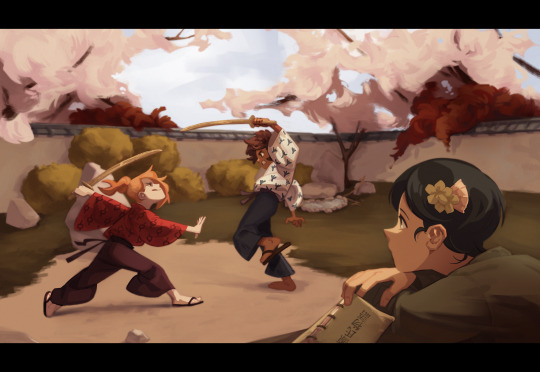
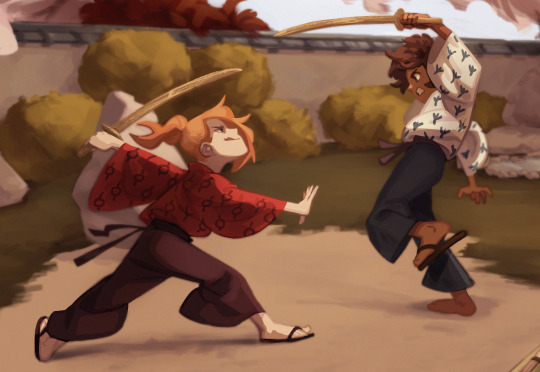

Sparring in the garden. (Samurai AU)
#amphibia#samurai au#marcy wu#anne boonchuy#sasha waybright#back when I refused to study backgrounds#Marcy is reading The Tale of Genji#my art
703 notes
·
View notes
Text

The Tale Of Genji, 1987
78 notes
·
View notes
Text

reading asaki yumemishi was one of the best experience i've had with a manga. if you love japanese history and traditional literature you should try it!
#asaki yumemishi#genji monogatari#tale of genji#waki yamato#murasaki shikibu#asaki yumemishi: genji monogatari#1979#70s#70s shojo manga#shoujo#shoujo manga#vintage shojo#shojo#retro shojo#vintage shoujo#retro shoujo#manga vintage#manga#manga aesthetic#manga art#manga and stuff#manga screenshots#manga screencap#manga panel#manga recommendation#recommendation#my opinion#thoughts#classic literature#classic japanese literature
39 notes
·
View notes
Text
reading middlemarch for the first time rn and oh my god it is so. good? like unbelievably so. my god it’s actually astonishing me
45 notes
·
View notes
Note
bonnie is in dante aligheri's Divine Comedy
Bonnie is in the Divine Comedy!

#where is bonnie?#bonnie in a location#in stars and time#isat#isat bonnie#ask#i didn’t know what I was signing up for when I created this blog#what’s next?#The epic of gilgamesh?#the tale of genji?#the illiad?#not actually annoyed btw i think this is very funny
31 notes
·
View notes
Note

Hello! i saw your kimono drawing guide, and i have some questions. I saw this art and was wondering about a few things: what is the tied knot& tassel things on the sleeves for? and, what hairstyle is the lady wearing? If you know, please tell me! If you don't know, could it be possible to direct me to someone that might? Thank you for taking the time to answer, if you're able! Have a lovely night/day!
Hi and thank you for your question :) The ukiyoe you are sharing is by Utagawa Kunisada and titled Genji rokujo no hana (源氏六條の花), or "Cherry Blossoms at Genji's Rokujô Mansion". It is part of a three prints set:

It depicts an imaginary scenery from The tale of Genji, and the young lady playing with her pet cat is the princess Onna San no Miya.
Characters are not shown wearing period accurate clothes (from Heian era), but luscious Edo period attires. Because of her rank, the young princess is wearing what Edo princesses would, especially the trademark hairstyle named fukiya 吹輪.
You'll find below a translation from a costume photobook I did a while ago. Note the big bridge style front hairpin, and the drum like one in the back. Princesses from the buke (samurai class) would also have dangling locks called aikyôge (I also found the term okurege), but I am not sure kuge princesses (noble class) wore them too.

There is a whole dispute about this hairstyle, as we are not actually sure it was worn as such by actual princesses. This style may have in fact started as a somehow cliché bunraku/kabuki costume used to depict princesses (think a bit like Western Cinderella-types princess gowns). Nowadays, it is found only as a theater style, or worn by Maiko during Setsubun season.
For comparison, here is character Shizuka Gozen from kabuki play Yoshitsune Senbon Zakura:
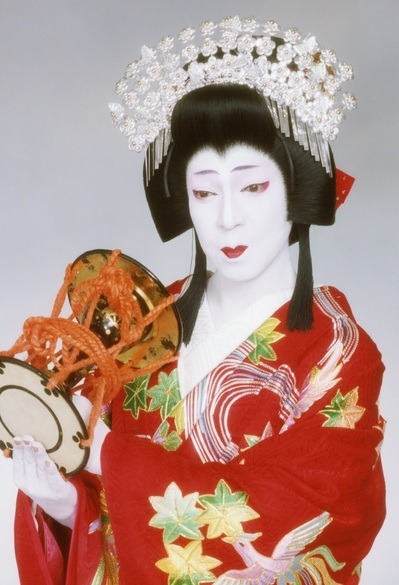
As for the dangling cords, I covered those in a past ask about kamuro that you can find here (part 1 / part 2). TL:DR: I am still not sure what is the exact name for those decorations (kazari himo? sode no himo?).
But their use is pretty much linked to 3 things:
1) luck + protection (knots have auspicous meanings),
2) reinforcing weak points of garnment (here: sleeves wrist opening)
3) cuteness impact, as much like furisode (long sleeves kimono) those dangling ribbons were mostly seen on girls/young unmarried ladies by the Edo period
All the design elements chosen by Utagawa Kunisada for his Onna San no Miya stress own young and carefree she is still (which considering her narrative arc is in fact a bit sad... like all Genji Monogatari stories). BUT: bonus points for pet cat!
Hope that helps :)
#japan#kimono#ask#fashion history#art history#ukiyoe#The tale of Genji#genji monogatari#Utagawa Kunisada#hime#princess#onna San no Miya#nihongami#japanese hairstyle#fukiya#katsuyama#kazari himo#sode no himo#dangling ribbon#kamuro#kumihimo#ribbon#cord
497 notes
·
View notes
Text
Hikaru Kimi e

Starting this drama because I keep hearing about it and The Tale of Genji has been on my to-read list since forever. So. Now is as good a time as any to get started down this path.
***
Starting out strong! A cursed star is shining upon the city. A calamity is upon them.

***
Good girl.

Typical of the father, pouring all his energy into the useless son, and it is his daughter who will turn out to be successful.
***
The baby looks delighted at the prospect of being the Emperor's hundred-and-fifth wife, LMAO.


Yell, baby! Yell!
***
I can't decide whether to laugh or cry 😭😂



***
Oh my god 😅


***
Cackling 🤣🤣

Anyway, I should start a list of these names. I've already forgotten what his brothers are called.
***
Oh, Akiko 😔


The situation doesn't look good, indeed.
***
The loser can't even feed one family, let alone multiple.


He's also ugly as sin while the wife is a goddess. The unfairness of it all.
***
Poor Akiko.

And just when she found the Emperor mildly fuckable.
***
LMAO



Hold that grudge, girl! How dare he forget the sweets?
***
Charmed.

***
Oh, Jesus Christ.


What the hell.
What the fuck did just happen.
***
And he's waiting for her 😭

And he brought the sweets 😭😭
***
Piece of shit.



23 notes
·
View notes
Text
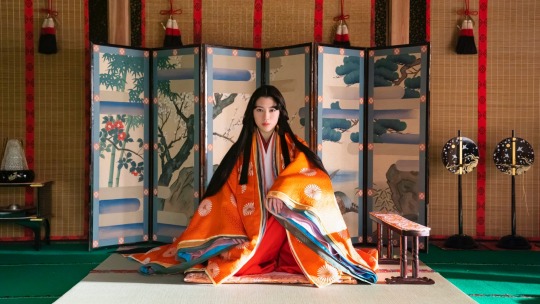
Ayaka Miyoshi in Junihitoe wo Kita Akuma / The Devil Wears Junihitoe Kimono (2020)
#ayaka miyoshi#miyoshi ayaka#junihitoe ko kita akuma#the devil wears junihitoe kimono#十二単衣を着た悪魔#tale of genji#heian period#japanese movie#j movie#japanese drama#j drama#jdrama#dorama#japan#asian drama#asian movie
113 notes
·
View notes
Text
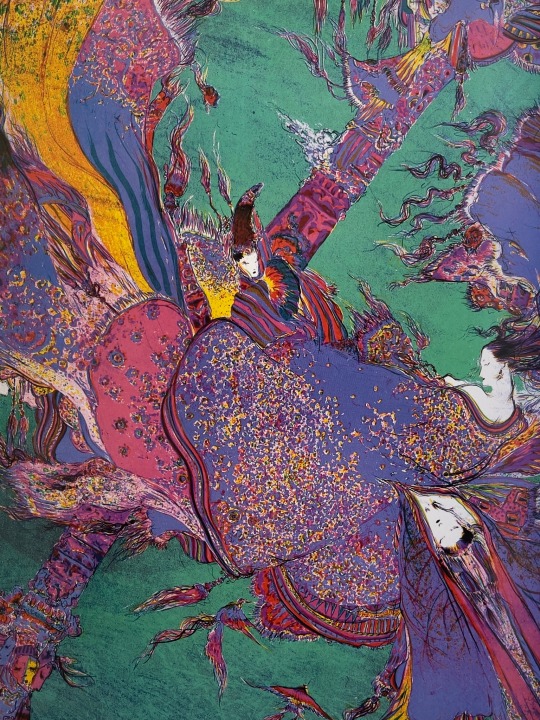
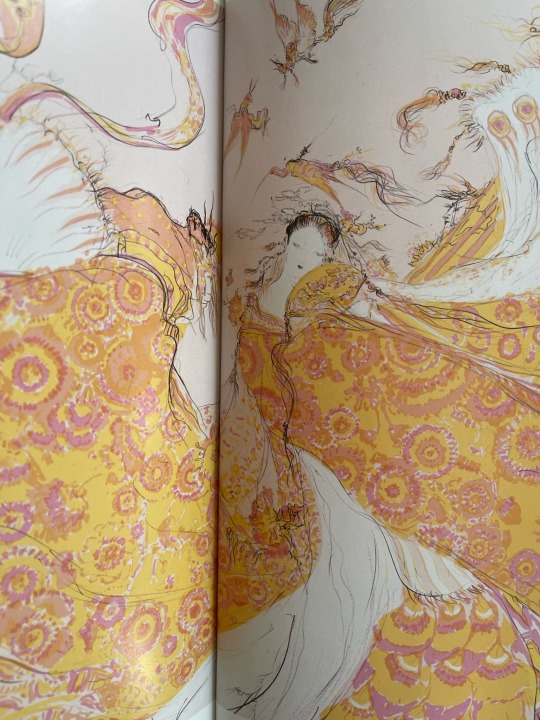
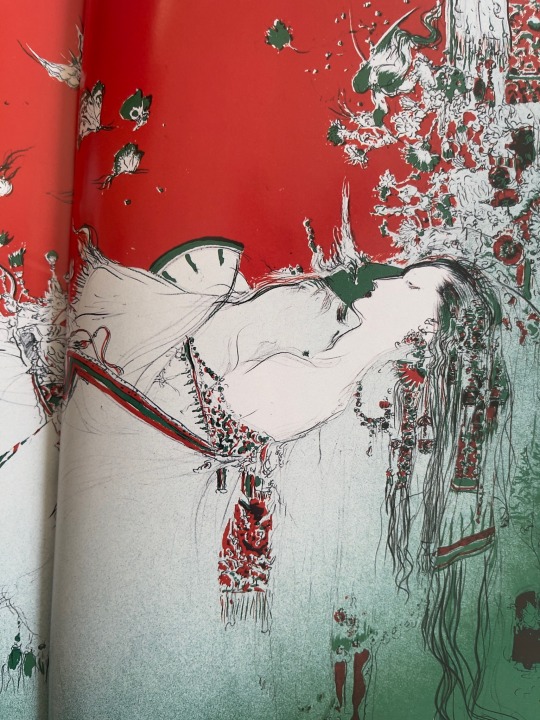


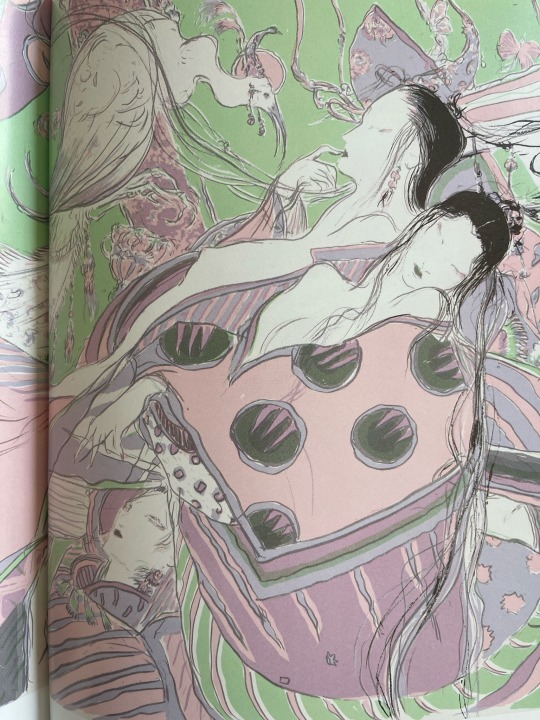
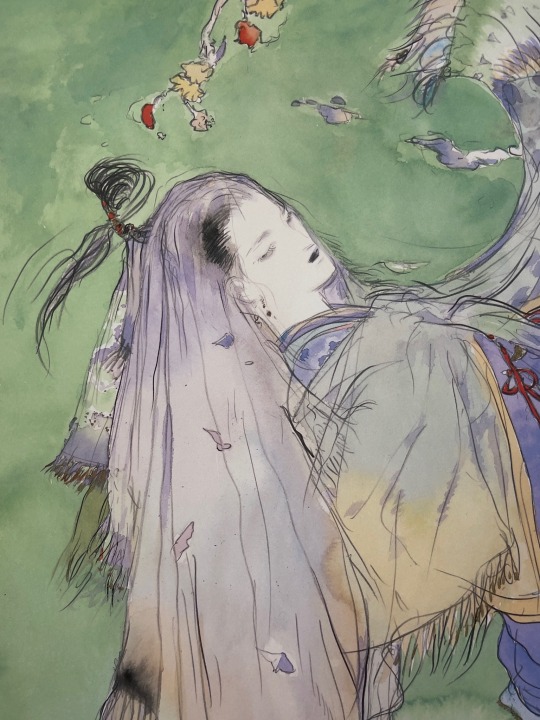

Yoshitaka Amano: The Tale of Genji (2006)
2K notes
·
View notes
Text




Murasaki Shikibu: Author of The Tale of Genji.
After exploring the stunning Byodo-in Temple, I made my way to the Uji Bridge, an iconic spot in this charming town. Sitting proudly near the bridge is the elegant Statue of Murasaki Shikibu, a tribute to one of Japan's most celebrated authors. Known for penning The Tale of Genji, often hailed as the world's first novel, Murasaki Shikibu’s statue exudes an air of grace and wisdom. Her serene expression and flowing robes seem to capture the essence of timeless beauty, and I couldn’t help but imagine her sitting by the river, penning her masterpiece amidst the tranquil surroundings.
The Uji Bridge itself has a long history, dating back to the Asuka Period (7th century), making it one of the oldest bridges in Japan. Though the current version is a reconstruction, it still carries the weight of centuries of stories—much like Murasaki Shikibu herself. The gentle flow of the Uji River beneath the bridge and the lush greenery surrounding it created a peaceful atmosphere.
As I stood there admiring the scene, I couldn’t help but think how fitting it was that Murasaki Shikibu’s statue is located here. Her work has bridged cultures and centuries, much like the bridge behind her spans the serene Uji River. It’s a spot where history, literature, and natural beauty come together—a true gem of Uji.
—Emmy
#japan#japan travel#travel#japan photos#日本#Kyoto#Uji#Tales of Genji#Novel#Book#Anime#Manga#japanese#History#Writer#Author#River
11 notes
·
View notes
Text

what if I rewrote the Tale of Genji in the modern day. what then.
19 notes
·
View notes
Text
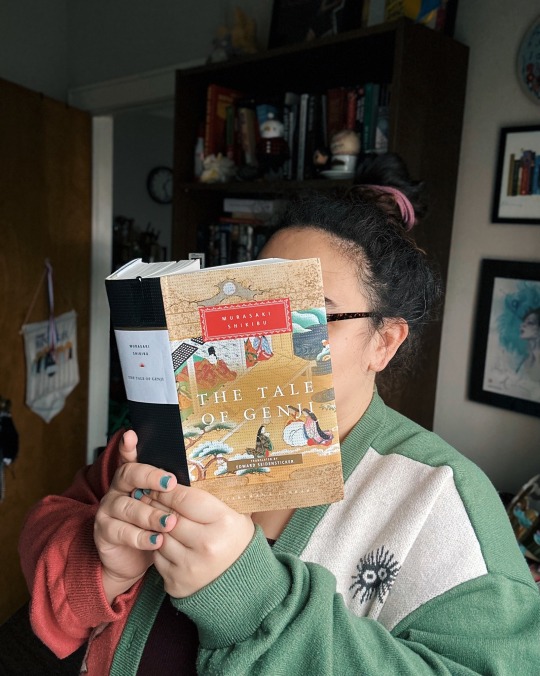
I’m still just getting my thoughts together on The Tale of Genji by Lady Murasaki Shikibu, translated by Edward G. Seidensticker, which was an epic that took me by surprise. Considered by many to be the first known novel, written in the early 11th century in Japan by a woman at court, this book is full of drama, wit, poetry, and messiness.
Genji is his father’s favorite. A beautiful, naturally charming prince, he is considered to be too good to be true—there was an idea that if too beautiful, you would be doomed to die early. His father is unable to name him crown prince due to court politics, and so he is a commoner at court, but one of tremendous influence. Genji is in love with love, and chases after women left and right—but is very serious about these affairs, making it a point not to abandon the women he seduces. It is a story of romance, intrigue, and growth.
One thing I was surprised by is the modern-feeling self-awareness of the text. Many analyses identify the 2nd protagonist, Kaoru, as possibly the first anti-hero, but I’d argue Genji is. Like many early mythic figures, he is loved by all but not without flaws. When he adopts (kidnaps) Lady Murasaki at a young age specifically to groom her into a future wife, the text does not shy away from how inappropriate it is. Characters disapprove, and the text is often cynical or wry about Genji’s choices. It does the same when Genji’s seductions turn coercive. It forgives Genji, but does excuse him, and that was something I did not expect from such an early text. This reflectiveness is part of what makes the book feel like a novel, rather than an epic poem of some kind.
#the tale of genji#murasaki shikibu#books in translation#classic literature#japanese literature#my book reviews#tale of genji
66 notes
·
View notes
Text
















源氏物語 (Yoshitaka Amano)
10 notes
·
View notes